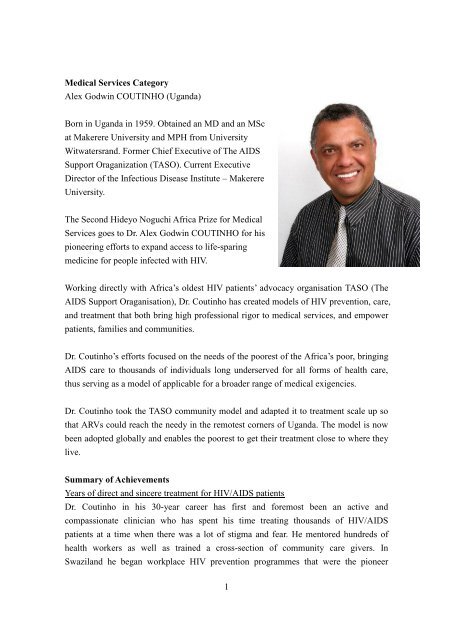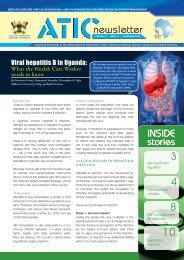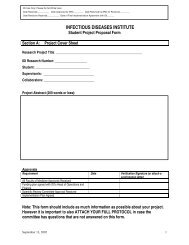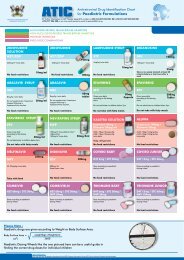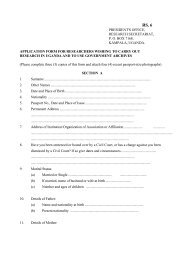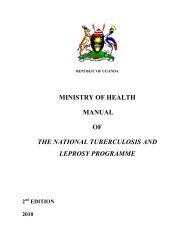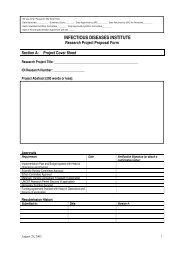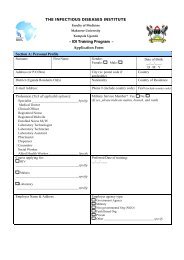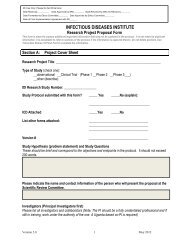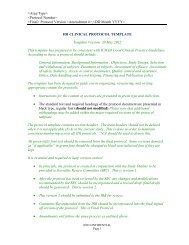1 Medical Services Category Alex Godwin COUTINHO - Infectious ...
1 Medical Services Category Alex Godwin COUTINHO - Infectious ...
1 Medical Services Category Alex Godwin COUTINHO - Infectious ...
You also want an ePaper? Increase the reach of your titles
YUMPU automatically turns print PDFs into web optimized ePapers that Google loves.
<strong>Medical</strong> <strong>Services</strong> <strong>Category</strong><br />
<strong>Alex</strong> <strong>Godwin</strong> <strong>COUTINHO</strong> (Uganda)<br />
Born in Uganda in 1959. Obtained an MD and an MSc<br />
at Makerere University and MPH from University<br />
Witwatersrand. Former Chief Executive of The AIDS<br />
Support Oraganization (TASO). Current Executive<br />
Director of the <strong>Infectious</strong> Disease Institute – Makerere<br />
University.<br />
The Second Hideyo Noguchi Africa Prize for <strong>Medical</strong><br />
<strong>Services</strong> goes to Dr. <strong>Alex</strong> <strong>Godwin</strong> <strong>COUTINHO</strong> for his<br />
pioneering efforts to expand access to life-sparing<br />
medicine for people infected with HIV.<br />
Working directly with Africa’s oldest HIV patients’ advocacy organisation TASO (The<br />
AIDS Support Oraganisation), Dr. Coutinho has created models of HIV prevention, care,<br />
and treatment that both bring high professional rigor to medical services, and empower<br />
patients, families and communities.<br />
Dr. Coutinho’s efforts focused on the needs of the poorest of the Africa’s poor, bringing<br />
AIDS care to thousands of individuals long underserved for all forms of health care,<br />
thus serving as a model of applicable for a broader range of medical exigencies.<br />
Dr. Coutinho took the TASO community model and adapted it to treatment scale up so<br />
that ARVs could reach the needy in the remotest corners of Uganda. The model is now<br />
been adopted globally and enables the poorest to get their treatment close to where they<br />
live.<br />
Summary of Achievements<br />
Years of direct and sincere treatment for HIV/AIDS patients<br />
Dr. Coutinho in his 30-year career has first and foremost been an active and<br />
compassionate clinician who has spent his time treating thousands of HIV/AIDS<br />
patients at a time when there was a lot of stigma and fear. He mentored hundreds of<br />
health workers as well as trained a cross-section of community care givers. In<br />
Swaziland he began workplace HIV prevention programmes that were the pioneer<br />
1
programmes in southern Africa. He also established excellent clinical facilities even<br />
before public programmes started dedicated HIV services.<br />
Demonstration of models of care and treatment at TASO<br />
Dr. Coutinho’s main contributions were when he took over the leadership of TASO and<br />
demonstrated models of scaled up care and treatment that have been copied and<br />
emulated around the world. In particular in TASO, he pioneered home-based care<br />
including home-based and community-based delivery of antiretroviral therapy. TASO is<br />
a world leader in engaging and involving HIV+ people in their care and this practice led<br />
to the establishment of GIPA (Greater Involvement of People Living with HIV/AIDS).<br />
Within TASO alone, Dr. Coutinho led a programme that tested over 1 million people<br />
and started 100,000 HIV+ onto a care and treatment programme. After joining the<br />
<strong>Infectious</strong> Disease Institute (IDI) in 2007, Dr. Coutinho through the IDI programmes<br />
continued his scale-up of care and treatment and added another 60,000 HIV+ people on<br />
care and treatment over the next 5 years and in addition tested another 800,000 across<br />
Uganda. Dr. Coutinho has also led IDI to develop innovative capacity building<br />
programmes that have enabled districts to scale up HIV prevention care and treatment<br />
including male circumcision and comprehensive PMTCT (preventing mother-to-child<br />
transmission).<br />
Support for development of the next-generation HIV prevention tools<br />
Through his work with the International Partnership for Microbicides (IPM) and the<br />
International AIDS Vaccine Initiative (IAVI), Dr. Coutinho has contributed to<br />
knowledge towards a new generation of HIV prevention tools and in fact IPM is now in<br />
a Phase III trial of a dapivirine ring that could change the face of HIV prevention in<br />
Africa. IDI has also been one of the sites that has successfully researched pre-exposure<br />
prophylaxis (PrEP) in discordant couples.<br />
Development of approaches for HIV/AIDS management (control)<br />
Dr. Coutinho has pioneered several approaches to managing HIV/AIDS that have led to<br />
scale-up of HIV programmes within Africa and improved the prevention of HIV as well<br />
as ensured that millions access good quality care and treatment. This has been achieved<br />
through:<br />
(1) The scale-up of programmes like home-based HIV testing, home-based care and<br />
treatment, PMTCT, and medical male circumcision. Conservatively, the work that Dr.<br />
2
Coutinho has led has touched the lives of over 1,000,000 people in Uganda and<br />
probably many more than that in the rest of Africa.<br />
(2) Scale-up of capacity building programmes in TASO, IDI and the Regional AIDS<br />
Training Network (RATN) that have trained thousands of health workers across<br />
Africa—a conservative estimate over the past 10 years is 30,000 health workers trained<br />
between TASO and IDI while Dr. Coutinho has been at their helm.<br />
(3) Research to policy by supporting research that has taken place in TASO and IDI and<br />
guiding its adoption into national and global policy. This includes among others the use<br />
of co-trimoxazole as an opportunistic infection prophylaxis in HIV+ people, the<br />
adoption of home-based management and treatment protocols that have led to<br />
decongestion of health facilities, the use of rapid testing algorithms, the prophylaxis of<br />
cryptococcal meningitis and the demonstration of task shifting for medical male<br />
circumcision.<br />
Dr. Coutinho with the staff of<br />
IDI looking at the chest Xray<br />
of a patient co-infected with<br />
HIV and Tuberculosis. IDI is<br />
pioneering research and<br />
treatment approaches for<br />
managing this killer<br />
combination.<br />
3<br />
Dr. Coutinho standing in the<br />
HIV clinic of IDI. The Clinic<br />
treats 400 patients a day and<br />
serve 10,000 patients (4,000<br />
of them complicated HIV) –<br />
one of the largest clinic under<br />
one roof in Africa.
Dr. Coutinho meeting district<br />
officials and health staff in a<br />
remote rural area on the<br />
Uganda / Democratic Republic<br />
of Congo Border. IDI working<br />
with TASO provides HIV<br />
counseling and testing services<br />
and HIV treatment to people<br />
from both countries. This<br />
program is funded by CDC/US<br />
government.<br />
Point of contact to the prize laureate<br />
13 March -16 March, 2013, Dr. Coutinho stays at Hotel Andaz Wall Street,<br />
75 Wall Street, New York, 10005 USA<br />
Tel +1 212 590 1234 FAX +1 212 590 1238 Email wall.guest@andaz.com<br />
Dr. <strong>Alex</strong> G. Coutinho<br />
Tel +256 776 767 638 Email: acoutinho@idi.co.ug<br />
INFECTIOUS DISEASES INSTITUTE<br />
P.O. Box 22418, Kampala, Uganda<br />
Tel +256 784 818 737 Website: http://idi.mak.ac.ug<br />
4<br />
Dr. Coutinho mentoring a joint<br />
meeting between IDI, Baylor<br />
College Uganda, Ministry of<br />
Health and Ugandan<br />
Association of Obstetrics. The<br />
meeting was discussing how to<br />
improve Obstetric care<br />
including HIV care for pregnant<br />
women in Uganda.
Press Release<br />
Decision of the Laureates of<br />
the Second Hideyo Noguchi Africa Prize<br />
5<br />
March 13, 2013<br />
Cabinet Office<br />
The government of Japan has decided to award the Second Hideyo Noguchi Africa<br />
Prize to Dr. Peter PIOT (Belgium) and Dr. <strong>Alex</strong> <strong>Godwin</strong> <strong>COUTINHO</strong> (Uganda).<br />
<strong>Medical</strong> Research <strong>Category</strong><br />
Peter PIOT (Belgium)<br />
Born in Belgium in 1949. Obtained M.D. at University<br />
of Ghent, and Ph.D. (Microbiology) at University of<br />
Antwerp. Current Director and Professor of the<br />
London School of Hygiene and Tropical Medicine.<br />
The Second Hideyo Noguchi Africa Prize for <strong>Medical</strong><br />
Research goes to Dr. Peter Piot for his pivotal research<br />
on diseases endemic to much of the African continent,<br />
including HIV, Ebola, chlamydia, tuberculosis and<br />
gonorrhea.<br />
Personifying an unusual combination of research on the ground in multiple African<br />
locations and worldwide policy strategy, Professor Piot has applied his scientific<br />
discoveries and insights to people all over the world, especially in Africa.<br />
Beginning in 1976, Dr. Piot, then at the Institute for Tropical Medicine in Antwerp,<br />
Belgium, devoted indefatigable energies to the epidemiology, virology and clinical<br />
analysis of diseases of devastating impact in Africa, and dedicated years of his life to<br />
research and training all over the continent.<br />
Dr. Piot was part of the team that discovered Ebola in Zaire (currently the Democratic<br />
Republic of the Congo) in 1976, and among the first to confirm the presence of<br />
heterosexually transmitted HIV and pediatric AIDS in Africa, as well as the association<br />
between HIV infection and tuberculosis in Africa.<br />
Through his prominently published scientific papers, and powerful role on the global
stage, Dr. Piot has brought the HIV pandemic to the forefront of global attention and<br />
concern, raised international commitments to its funding and control, and built<br />
scientifically grounded responses to the control and treatment of the disease.<br />
Summary of Achievements<br />
Pioneering research work on the scene<br />
Dr. Peter Piot made various contributions to the prevention and control of infectious<br />
diseases in Africa, by leading international research teams and carrying out fieldwork.<br />
When the first known outbreak of Ebola hemorrhagic fever occurred in Yambuku, Zaire,<br />
in 1976, Dr. Piot and his colleagues identified a new filamentous Marburg-related virus<br />
in blood samples sent to the Microbiology Department of the Institute of Tropical<br />
Medicine in Antwerp. He then became the director of operations of the first<br />
international team carrying out fieldwork in the Yambuku area, and provided the first<br />
clinical description and epidemiological features based on his work on the scene. This<br />
first investigation provided the foundation for controlling subsequent Ebola and<br />
hemorrhagic fever outbreaks in Africa.<br />
Together with Kenyan and Canadian colleagues, Dr. Piot started a research team on<br />
Sexually Transmitted Infections (STI) in Nairobi, Kenya, in the early 1980s. His team<br />
focused on infectious diseases in both mother and child. Their work led to a new<br />
understanding of the importance of the control of STI for the health of mother and child,<br />
and also led to the development of new interventions. The results have been<br />
incorporated into WHO prevention and clinical management guidelines still widely used<br />
in Africa and beyond.<br />
In 1983, Dr. Piot led a research team in Kinshasa which revealed a major, till-then<br />
undocumented, heterosexual AIDS epidemic in Central Africa, leading to a landmark<br />
publication in The Lancet in 1984. He co-founded the first international research<br />
program on HIV/AIDS in Africa, and generated the basics of our knowledge on the<br />
epidemiology and clinical expression of HIV infection.<br />
Dr. Piot’s collaborative studies in Nairobi and Kinshasa elucidated particular biological<br />
and behavioral risk determinants of heterosexual transmission, and were the first to<br />
suggest a protective effect of male circumcision against HIV infection, which was later<br />
proven in a randomized trial and is now implemented in several countries. His research<br />
6
teams also conducted the early studies defining the rate of mother-to-child transmission<br />
of HIV and associated risk factors, and reported on the first successful preventative<br />
interventions against the spread of HIV among high-risk populations in Africa. His<br />
laboratory isolated highly divergent strains of HIV-1 from Africa, identified simian<br />
immunodeficiency viruses in chimpanzees (SIVcpz), and documented the wide genetic<br />
diversity of HIV-1 in Africa.<br />
Dr. Piot and his team were the first to recognize the importance of HIV/Tuberculosis<br />
(TB) co-infection in Africa. TB is now the major killer of HIV-positive individuals in<br />
Africa. They demonstrated that standard treatment regimens for TB in Africa were<br />
ineffective in patients co-infected with HIV, and described the distinct clinical<br />
manifestations and diagnostic features of HIV/TB coinfection. Their work led to<br />
developing new clinical management and treatment guidelines for TB in Africa.<br />
Since the 1990s, Dr. Piot has been serving as a global leader in the health field of the<br />
United Nations, WHO, etc. He played an active role in developing an international<br />
funding mechanism for the fight against AIDS, TB and Malaria (the Global Fund). His<br />
work contributed significantly to the decline of mortality due to AIDS and of new HIV<br />
infections in Africa.<br />
International team arriving in Yambuku,<br />
Zaire to investigate Ebola Outbreak, 20<br />
Oct 1976<br />
7<br />
Addressing UN General Assembly<br />
in 2005 (UN AIDS photo)
Point of contact to the prize laureate<br />
Mr Patrick Wilson,<br />
Head of Communications at the London School of Hygiene & Tropical Medicine<br />
Keppel Street, London WCIE 7HT, UK<br />
Tel +44 (0)20 7636 8636<br />
Fax +44 (0)20 7436 5389<br />
Email: Patrick.Wilson@lshtm.ac.uk<br />
URL: http://www.lshtm.ac.uk/<br />
Dr. Kapita and Colleagues at the Hospital of Kinshasa<br />
Addressing Community in Livingston, Zambia<br />
8
[Date of birth]<br />
February 17, 1949 (in Belgium)<br />
[Education and Research Career]<br />
Brief Personal Record of Dr. Peter PIOT<br />
1974 M.D., University of Ghent (Belgium)<br />
1980 Ph.D. (Microbiology), University of Antwerp<br />
1981-1992 Professor and chair, Department of Microbiology and Immunology,<br />
Institute of Tropical Medicine, Antwerp, Belgium<br />
1986-1987 Associate Professor, <strong>Medical</strong> Microbiology, University of Nairobi<br />
(Kenya)<br />
1992-1994 Associate Director, Global Programme on AIDS, World Health<br />
Organisation (WHO)<br />
1995 Executive Director, Joint United Nations Programme on HIV/AIDS<br />
(UNAIDS), and Under Secretary-General of the UN, Geneva<br />
2009 Senior Fellow, Bill & Melinda Gates Foundation, Seattle<br />
2009-2010 Professor of Global health, Imperial College for Science,<br />
Technology and Medicine, London<br />
2009-2010 Chair “Knowledge against Poverty”, College de France, Paris<br />
2010 Director and Professor of Global health, London School of Hygiene<br />
[Honors and Awards]<br />
& Tropical Medicine, UK<br />
1986 Royal Academy of Medicine, Belgium<br />
1995 Knighted as a Baron by King Albert -II of Belgium<br />
2000 Institute of Medicine, US National Academies of Sciences<br />
2002 Gold Medal, Royal Academy of Sciences, Belgium<br />
2010 National Academy of Medicine, France<br />
2011 UK Academy of <strong>Medical</strong> Sciences<br />
[Major Publications]<br />
Work relating to viral haemorrhagic fever<br />
1. Pattyn, S., G. van der Groen, G. Courteille, W. Jacob, and P. Piot. 1977. Isolation of<br />
Marburg-like virus from a case of haemorrhagic fever in Zaire. Lancet 1:573-574.<br />
9
2. Piot P., P. Sureau, J. Breman, et al. 1978. Clinical aspects of Ebola virus-infection in<br />
Yambuku-area. In SR Pattyn (Editor) Ebola virus haemorrhagic fever. Elsevier,<br />
Amsterdam.<br />
Work relating to infectious diseases on mothers and children<br />
3. Laga, M., H. Nzanze, R. C. Brunham, G. Maitha, J. D. D'C. Lourdes, J. K. Mati, M.<br />
Ceang, F. A. Plummer, W. Namaara, J. O. Ndinya-Achola, A. R. Ronald, V; B. Bhullar,<br />
L. Fransen, P. Piot. 1986. Epidemiology of ophthalmia neonatorum in Kenya. Lancet<br />
2:1145-1149.<br />
4. Laga, M., F. A. Plummer, P. Piot, P. Datta, W. Namaara, J. O. Ndinya-Achola, H.<br />
Nzanze, G. Maitha, A. R. Ronald, H. O. Pamba, R. C. Brunham. 1988. Prophylaxis of<br />
gonococcal and chlamydial ophthalmia neonatorum. A comparison of silver nitrate and<br />
tetracycline. The New England Journal of Medicine 318:653-657.<br />
5. Elliott, B., R. C. Brunham, M. Laga, P. Piot, J. O. Ndinya-Achola, G. Maitha, M.<br />
Cheang, and F. A. Plummer. 1990. Maternal gonococcal infection as a preventable risk<br />
factor for low birth weight. The Journal of <strong>Infectious</strong> Diseases 161:531-536.<br />
6. Temmerman, M., E. N. Chomba, J. Ndinya-Achola, F. A. Plummer, M. Coppens, and<br />
P. Piot. 1994. Maternal human immunodeficiency virus-1 infection and pregnancy<br />
outcome. Obstetrics and Gynecology 83:495-501.<br />
Work relating to HIV/AIDS<br />
7. Piot, P., H. Taelman, K. B. Minlangu, N. Mbendi, K. Ndangi, K. Kalambayi, C.<br />
Bridts, C. Quinn, F. M. Feinsod, O. Wobin, P. Mazebo, W. Stevens, S. Mitchell, J. B.<br />
Mccormick. 1984. Acquired immunodeficiency syndrome in a heterosexual population<br />
in Zaire. Lancet 2:65-69.<br />
8. Quinn, T. C., J. M. Mann, J. W Curran, and P. Piot. 1986. AIDS in Africa: an<br />
epidemiologic paradigm. Science 234:955-963.<br />
9. Ryder, R. W, W. Nsa, S. E. Hassig, F. Behets, M. Rayfield, B. Ekungola, A. M.<br />
Nelson, U. Mulenda, H. Francis, K. Mwandagalirwa, F. Davachi, M. Rogers, N.<br />
Nzilarmbi, A. Greenberg, J. Mann, T. C. Quinn, P. Piot, J. W. Curran. 1989. Perinatal<br />
transmission of the human immunodeficiency virus type 1 to infants of seropositive<br />
women in Zaire. The New England journal of Medicine, 320:1637-4642.<br />
10. De Leys R, Vanderborght B, Haesevelde M, Heyndrickx L, Van Geel A, Wauters C,<br />
Bernaerts R, Saman E, Nys P, Willems B, Taelman H, van der Groen G, Piot P,<br />
Tersmette T, Huisman JG, Van heuverswijn H. 1990. Isolation and partial<br />
characterization of an unusual human immunodeficiency retrovirus from two persons of<br />
West – Central African origin. J Virol 64:1207-16 249<br />
11. Peeters, M., K. Fransen, E. Delaporte, M. Van den Haesevelde, G. M. Gershy-Damet,<br />
10
L. Kestens, G. van der Groen, and P. Piot. 1992. Isolation and characterization of a new<br />
chimpanzee lentivirus (simian immunodeficiency virus isolate cpz-ant) from a<br />
wild-captured chimpanzee. AIDS 6:447-451.<br />
12. Janssens W, Fransen K, Peeters M, heyndrickx L, Motte J, Bedjabaga L, Delaporte<br />
E, Piot P and van der Groen G., 1994. Phylogenetic analysis of a new chimpanzee<br />
lentivirus SIV cpz-gab2 from a wild-captured chimpanzee. AIDS 6: 447-451.<br />
13. Nyambi PN, Lewi P, Peeters M, Janssens W, Heyndricks L, Fransen K, Andries K,<br />
Vanden Haesevelde M, Heeney J, Piot P, van der Groen G., 1997 . Study of the<br />
dynamics neutralization escape mutants in a chimpanzee naturally infected with the<br />
simian immunodeficiency virus (SIVcpz-ant). J Virol 71:2320-30<br />
14. Laga, M., A. Manoka, M. Kivuvu, B. Malele, M. Tuliza, N. Nzila, Goeman, F.<br />
Behets, V. Batter, M. Alary, W. L. Heyward, R. W. Ryder, P. Piot. 1993. Non-ulcerative<br />
sexually transmitted diseases as risk factors for HIV-1 transmission in women: results<br />
from a cohort study. AIDS 7:95-102.<br />
15. Laga M, Alary M, Nzila N, Manoka AT, Tuliza M, Behets F, Goeman J, St Louis M,<br />
Piot P. 1994. Condom promotion and STD treatment leading to a declining incidence of<br />
HIV-1 infection in a cohort of high risk women. Lancet 344:246-8<br />
16. Piot, P., M. Bartos, P. D. Ghys, N. Walker, and B. Schwartlander. 2001. The global<br />
impact of HIV/AIDS. Nature 410:968-973.<br />
17. Piot P, Bartos M, Larson H, Zewdie D, Mane P.2008. Coming to terms with<br />
complexity: a call to action for HIV prevention. Lancet 372:854-59<br />
Work relating to HIV/Tuberculosis<br />
18. Colebunders RL., Ryder RW, Nzila N, Kalunga D, Willame JC, Mulumba K, Nkoko<br />
B, Jeugmans J, Kalala M, Francis HL, Mann JW, Quinn TC, Piot P. 198. HIV infection<br />
in patients with tuberculosis in Kinshasa, Zaire. Am Rev Resp Dis 139: 1082-5<br />
19. Mukadi Y, Perriens JH, St Louis ME, Brown C, Prignot J, Willame JC, Pouthier F,<br />
Kaboto M, Ryder RW, Portaels F, Piot P. 1993. Spectrum of immunodeficiency in HIV-1<br />
infected patients with pulmonary tuberculosis in Zaire. Lancet 342:143-6<br />
20. Perriens, J. H., M. E. St Louis, Y. B. Mukadi, C. Brown, J. Prignot, F. Pouthier, F.<br />
Portaels, J. C. Willame, J. K. Mandala, M. Kaboto, R. W. Ryder, G. Roscigno, P. Piot.<br />
1995. Pulmonary tuberculosis in HIV-infected patients in Zaire. A controlled trial of<br />
treatment for either 6 or 12 months. The New England Journal of Medicine<br />
332:779-784.<br />
11
[Date of birth]<br />
June 19, 1959<br />
[Education and Research Career]<br />
Brief Personal Record of Dr. <strong>Alex</strong> G. Coutinho<br />
1983 Obtained MB ChB, Makerere University, Uganda<br />
1983 Served as an intern at St. Francis Hospital Nsambya, and<br />
subsequently as a teaching assistant in the Faculty of Medicine,<br />
Makerere University; obtained MSc (Physiology)<br />
1989 Moved to Swaziland and initiated the very first HIV awareness and<br />
prevention programme in the private sector. Served as a clinician<br />
responsible for the emerging cases of HIV.<br />
2001 Returned to Uganda. Took office of Chief Executive of The AIDS<br />
Support Oraganization (TASO).<br />
2001 Served in the founding group that established the Global Fund to<br />
Fight AIDS, Tuberculosis and Malaria (GFATM), and subsequently<br />
served as the Vice Chair of the Technical Review Panel of the<br />
GFATM.<br />
2004-2008 Board member for the International Partnership for Microbicides<br />
(IPM)<br />
2007 Director of the <strong>Infectious</strong> Diseases Institute – Makerere University<br />
2008-2010 Chair of the Board for IPM<br />
At present Member of the board for the International AIDS Vaccine Initiative<br />
[Honors and Awards]<br />
(IAVI)<br />
2003 Global Humanitarian Action Award, the United Nations Association<br />
of the United States of America<br />
2012 Fellow of the Royal College of Physicians of the UK<br />
[Papers and Publications]<br />
1 Coutinho AG. Malignant Melanoma in Uganda. Presented at 1st Pan African<br />
Congress on Dermatology in Arusha, Tanzania, 1981.<br />
2 Coutinho AG. Iron Status in Ugandan Sicklers. Msc. Dissertation, 1987.<br />
12
3 Coutinho AG. Malaria Patterns in North East Swaziland. South African Epidemiol<br />
Infect 1994, Vol. 9(4), p108 - 111<br />
4 Coutinho AG. Diarrhoea and the use of Oral Rehydration solution (ORS) among<br />
sugar cane plantation workers in Swaziland. Do men and women have similar<br />
Knowledge, Attitudes and practices? DPH Dissertation, 1995.<br />
5 Coutinho AG. Preventing complicated malaria. S Afr Med J; 1996; 86: 1429-1430.<br />
6 Coutinho AG. Management of Severe and Complicated malaria in Swaziland Health<br />
units: Situational analysis commissioned by Malaria Control Programme and WHO<br />
offices – Swaziland, 1999.<br />
7 Coutinho AG. An assessment of the economic impact of HIV/AIDS on Royal<br />
Swaziland Sugar Corporation 1995-99. MPH research report - University of<br />
Witwatersrand, Johannesburg, 2000.<br />
8 Coutinho AG, Mkhonta F. HIV/AIDS - Human rights and ethics in Swaziland. A<br />
report prepared for UNDP - Swaziland, 2000.<br />
9 Coutinho AG, The impact of HIV on the sugar industry in Swaziland - a case study.<br />
AIDS ANALYSIS AFRICA Nov/Dec 2000 edition<br />
10 Coutinho AG, Kavumbura B. Is HIV/AIDS a risk factor for severe and complicated<br />
malaria? Presented at Malaria symposium for South Africa, Mozambique and Swaziland<br />
in Nelspruit, Nov 2000.<br />
11 Coutinho AG, Coutinho S. The impact of HIV on the human resource function of<br />
the civil service in Swaziland. A report prepared for Swaziland Government. 2001<br />
12 Coutinho AG, Muhangi L, Semakula R, Kakeeto-Lukubo M, Ochai R, Baryarama F,<br />
Hladik W, Bunnell R, Ransom R. Knowledge of partner HIV status and Condom use<br />
among HIV-positive TASO clients, Uganda, 2001. Poster ICASA 2001, Burkina Faso.<br />
13 Kizito F, Coutinho A. Common medical conditions amoung HIV-positive persons<br />
in TASO, 1997-2000. . Poster ICASA 2001, Burkina Faso.<br />
14 Lule JR, Mermin J, Malamba S, Downing R, Nakanjako D, Kigozi A, Wafula W,<br />
Hughes P, Kizito F, Coutinho A, Quick R. Pathogens in stools of HIV-positive persons<br />
with and without diarrhoea in Rural Uganda. . Poster ICASA 2001, Burkina Faso.<br />
15 Lule JR, Mermin J, Ekwaru JP, Malamba S, Downing R, Ransom R, Nakanjako D,<br />
Wafula W, Hughes P, Bunnell R, Kaharuza F, Coutinho A, Kigozi A, Quick R. Effect of<br />
home-based water chlorination and safe storage on diarrhea among persons with human<br />
immunodeficiency virus in Uganda. Am. J. Trop. Med. Hyg. 2005; 73(5) 926-933<br />
16 Mermin J, Lule J, Ekwaru JP, Downing R, Hughes P, Bunnell R, Malamba S,<br />
Ransom R, Kaharuza F, Coutinho A, Kigozi A, Quick R. Cotrimoxazole prophylaxis by<br />
HIV-infected persons in Uganda reduces morbidity and mortality among<br />
13
HIV-uninfected family members. AIDS 2005, 19:1035-1042<br />
17 Shrestha RK, Marseille E, Kahn JG, Lule JR, Pitter C, Blandford JM, Bunnell R,<br />
Coutinho A, Kizito F, Quick R, Mermin J. Cost effectiveness of home-based<br />
chlorination and safe water storage in reducing diarrhea among HIV-affected<br />
households in rural Uganda. Am. J. Trop. Med. Hyg. 2006 74(5) 884-890<br />
18 Nakayiwa S, Abang B, Packel L, Lifshay J, Purcell DW, King R, Ezati E, Mermin J,<br />
Coutinho A, Bunnell R. Desire for children and pregnancy risk behavior among<br />
HIV-infected men and women in Uganda. AIDS Behav DOI<br />
10.1007/s10461-006-9126-2<br />
19 Kaharuza F, Bunnell R, Moss S, Purcell DW, Bikaako-Kajura W, Wamai N,<br />
Downing R, Solberg P, Coutinho A, Mermin J. Depression and CD4 cell count among<br />
persons with HIV infection in Uganda. AIDS Behav DOI10.1007/s10461-006-9142-2<br />
20 Mermin J, Ekwaru JP, Liechty CA, Were W, Downing R, Ransom R, Weidle P,<br />
Lule J, Coutinho A, Solberg P. Effect of co-trimoxazole prophylaxis, antiretroviral<br />
therapy, and insecticide-treated bednets on the frequency of malaria in HIV-1-infected<br />
adults in Uganda: a prospective cohort study. Lancet 2006; 367: 1256-61<br />
21 Bunnell R, Ekwaru JP, Solberg P, Wamai N, Bikaako-Kajura W, Were W, Coutinho<br />
A, Liechty C, Madraa E, Rutherford G, Mermin J. Changes in sexual behavior and risk<br />
of HIV transmission after antiretroviral therapy and prevention interventions in rural<br />
Uganda. AIDS 2006; 20: 85-92<br />
22 Apondi R, Bunnell R, Awor A, Wamai N, Bikaako-Kajura W, Solberg P, Stall RD,<br />
Coutinho A, Mermin J. Home-based antiretroviral care is associated with positive social<br />
outcomes in a prospective cohort in Uganda, J Acquir Immune Defic Syndr 2006;<br />
23 Mbulaiteye SM, Katabira ET, Wabinga H, Parkin DM, Virgo P, Ochai R, Workneh<br />
M, Coutinho A, Engels EA. Spectrum of cancers among HIV infected persons in Africa:<br />
The Uganda AIDS-cancer Registry Match Study. Int. J. Cancer 2006; 118, 985-990<br />
24 Coutinho A, Mermin J. Integrating tuberculosis and HIV services in Africa. (Ed)<br />
INT J TUBERC LUNG DIS 2008 12(7):702<br />
25 Coutinho A, Roxo U, Epino H, Muganzi A, Dorward E, Pick B. The expanding<br />
role of civil society in the Global HIV/AIDS respose: What has the presidents<br />
emergency program for AIDS reliefs’s role been? J Acquir Immune Defic Syndr<br />
2012;60:S152–S157) (in press)<br />
14


